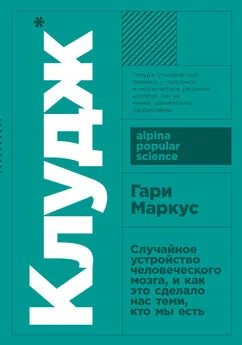Гари Маркус - Несовершенный человек. Случайность эволюции мозга и ее последствия.
- Название:Несовершенный человек. Случайность эволюции мозга и ее последствия.
- Автор:
- Жанр:
- Издательство:Альпина нон-фикшн
- Год:2011
- Город:Москва
- ISBN:978-5-91671-085-4
- Рейтинг:
- Избранное:Добавить в избранное
-
Отзывы:
-
Ваша оценка:
Гари Маркус - Несовершенный человек. Случайность эволюции мозга и ее последствия. краткое содержание
Человек привык считать себя венцом творения: свои сильные стороны – нормой, а слабости – отклонением. Подход автора принципиально другой: мы изначально несовершенны; наш мозг, как и тело, в ходе эволюции формировался достаточно случайно, из «подручных материалов» природы и являет собой так называемый клудж – нелепое, неуклюжее, но удивительно эффективное решение проблемы. Понятие клуджа проливает свет на важные стороны нашей жизни и объясняет множество проблем, с которыми мы сталкиваемся. Выводы автора оптимистичны: имея должное понимание соотношения сил и слабостей человеческого ума, мы получаем возможность помочь не только себе, но и обществу.
Несовершенный человек. Случайность эволюции мозга и ее последствия. - читать онлайн бесплатно ознакомительный отрывок
Интервал:
Закладка:
Kahneman, D., Krueger, А.В., Schkade, D.A., Schwarz, N., & Stone, A.A.(2006). Would you be happier if you were richer? A focusing illusion. Science, 312(5782), 1908-10.
Kahneman, D., & Ritov, I.(1994). Determinants of stated willingness to pay for public goods: A study in the headline method. Journal of Risk and Uncertainty, 9(1), 5-38.
Kassarjian, H.H., & Cohen, J.B.(1965). Cognitive dissonance and consumer behavior. California Management Review, 8, 55-64.
Kelly, A.V.(2001, January 19). What did Hitler do in the war, Miss? Times Educational Supplement, p. 12.
Kessler, R.C., Berglund, P., Demler, O., Jin, R., Merikangas, K.R., & Walters, E.E.(2005). Lifetime prevalence and age-of-onset distributions of DSM-IV disorders in the National Comorbidity Survey Replication. Chicago: American Medical Association.
Keysar, В., & Henly, A.S.(2002). Speakers' overestimation of their effectiveness. Psychological Science, 13(3), 207-12.
King, M.C, & Wilson, A.C.(1975). Evolution at two levels in humans and chimpanzees. Science, 188(4184), 107-16.
Kirscht, J.P., Haefner, D.P., Kegeles, S.S., & Rosenstock, I.M.(1966). A national study of health beliefs. Journal of Health and Human Behavior, 7(4), 248-54.
Klauer, K.C, Musch, J., & Naumer, B.(2000). On belief bias in syllogistic reasoning. Psychological Review, 10(4), 852-84.
Koehler, D.J.(1994). Hypothesis generation and confidence injudgment. Journal ofExperimental Psychology: Learning, Memory, and Cognition, 20(2), 461-469.
Koriat, A., Lichtenstein, S., & Fischhoff, В.(1980). Reasons for overconfidence. Journal of Experimental Psychology: Human Learning and Memory , 6, 107-118.
Kray, L.J., Galinsky, A.D., & Wong, E.M.(2006). Thinking within the box: The relational processing style elicited by counterfactual mind-sets. Journal of Personality and Social Psychology , 91, 33-48.
Kuhn, D.(2005). Education for thinking. Cambridge, MA: Harvard University Press.
Kuhn, D., & Franklin, S.(2006). The second decade: What develops (and how). In W. Damon & R. Lerner(Series Eds.), D. Kuhn & R. Siegler(Vol. Eds.), Handbook of child psychology (pp. 953-94). New York: Wiley.
Kunda, Z.(1990). The case for motivated reasoning. Psychological Bulletin , 108(3), 480-98.
Larrick, R.P.(2004). Debiasing. In D. Koehler & N. Harvey(Eds.), The Blackwell Handbook of Judgment and Decision Making (pp. 316-37). Maiden, MA: Blackwell.
Layard, P.R.G.(2005). Happiness: Lessons from a new science. New York: Penguin.
Leary, M.R., & Forsyth, D.R.(1987). Attributions of responsibility for collective endeavors. In C. Hendrick(Ed.), Group processes: Review of personality and social psychology, Vol. 8 (pp. 167-88). Thousand Oaks, CA: Sage.
Ledoux, J.E.(1996). The emotional brain: The mysterious underpinnings of emotional life. New York: Simon & Schuster.
Lerner, M.J.(1980). The belief in a just world: A fundamental delusion. New York: Plenum Press.
Leslie, S.-J.(2007). Generics and the structure of the mind. Philosophical Perspectives, 21(1), 378-403.
Liberman, N., Sagristano, M.D., & Trope, Y.(2002). The effect of temporal distance on level of mental construal. Journal of Experimental Social Psychology, 38(6), 523-34.
Lieberman, P. (1984). The biology and evolution of language. Cambridge, MA: Harvard University Press.
Linden, D.J.(2007). The accidental mind. Cambridge, MA: Belknap Press of Harvard University Press.
Linley, P.A., & Joseph, S.(2004). Positive change following trauma and adversity: A review. Journal of Traumatic Stress, 17(1), 11-21.
Lipman, M.(1970/1982). Harry Stottlemeier's discovery. Montclair, NJ: Institute for the Advancement of Philosophy for Children (IAPC).
Loftus, E.F.(2003). Make-believe memories. American Psychologist, 58(11), 867-73.
Lord, C.G., Ross, L., & Lepper, M.R.(1979). Biased assimilation and attitude polarization: The effects of prior theories on subsequently considered evidence. Journal of Personality and Social Psychology, 37(11), 2098-2109.
Luria, A.K.(1971). Towards the problem of the historical nature of psychological processes. International Journal of Psychology, 6(4), 259-72.
Lynch Jr., J.G., & Zauberman, G.(2006). When do you want it? Time, decisions, and public policy. Journal of Public Policy and Marketing, 25(1), 67-78.
Lyubomirsky, S., Caldwell, N.D., &Nolen-Hoeksema, S.(1998). Effects of ruminative and distracting responses to depressed mood on retrieval of autobiographical memories. Journal of Personality and Social Psychology, 75(1). 166-77.
Macrae, C.N., Bodenhausen, G.V., Milne, А.В., & Jetten, J.(1994). Out of mind but back in sight: Stereotypes on the rebound. Journal of Personality and Social Psychology, 67(5), 808-17.
Marcus, G.F.(1989). The psychology of belief revision. Bachelor's thesis, Hampshire College, Amherst, MA.
Marcus, G.F.(2004). The birth of the mind: How a tiny number of genes creates the complexities of human thought. New York: Basic Books.
Marcus, G.F., & Wagers, M.(under review). Tree structure and the structure of sentences: A reappraisal. New York University.
Marks, I., & Nesse, R.(1997). Fear and fitness: An evolutionary analysis of anxiety disorders. In S. Baron-Cohen (Ed.), The maladapted mind: Classic readings in evolutionary psychopathology (pp. 57-72). Hove, UK: Psychology Press.
Markus, G.B.(1986). Stability and change in political attitudes: Observed, recalled, and "explained." Political Behavior, 8(1), 21-44.
McClure, S.M., Botvinick, M.M., Yeung, N., Greene, J.D., & Cohen, J.D.(in press). Conflict monitoring in cognition-emotion competition. In J.J. Gross(Ed.), Handbook of emotion regulation. New York: Guilford.
Mealey, L.(1995). The sociobiology of sociopathy: An integrated evolutionary model. Behavioral and Brain Sciences, 18(3), 523-41.
Messick, D.M., Bloom, S., Boldizar, J.P., & Samuelson, C.D.(1985). Why we are fairer than others. Journal of Experimental Social Psychology, 21(5), 480-500.
Meston, С.M., & Buss, D.M.(2007). Why humans have sex. Archives of Sexual Behavior, 36(4), 477-507.
Metcalfe, J., & Shimamura, A.P.(1994). Metacognition: Knowing about knowing. Cambridge, MA: MIT Press.
Metzger, M.J., Flanagin, A.J., & Zwarun, L.(2003). College student Web use, perceptions of information credibility, and verification behavior. Computers and Education, 41(3), 271-90.
Miller, G., & Chomsky, N.A.(1963). Finitary models of language users. In R.D. Luce, R.R. Bush, & E. Galanter(Eds.), Handbook of mathematical psychology (Vol. II). New York: Wiley.
Miller, G.F.(2000). Evolution of human music through sexual selection. In N.L. Wallin, B. Merker, & S. Brown(Eds.), The origins of music (pp. 329-60). Cambridge, MA: MIT Press.
Minino, A.M., Arias, E., Kochanek, K.D., Murphy, S.L., & Smith, B.L.(2002). Deaths: Final data for 2000. National Vital Statistics Report, 50(15), 1-119.
Mischel, W., Shoda, Y., & Rodriguez, M.I.(1989). Delay of gratification in children. Science, 244(4907), 933-38.
Montague, R.(2006). Why choose this book? How we make decisions. New York: Dutton.
Montalbetti, M.M.(1984). After binding: On the interpretation of pronouns. Doctoral dissertation, MIT, Cambridge, MA.
Moseley, D., Baumfield, V., Higgins, S., Lin, M., Miller, J., Newton, D., Robson, S., Elliot, J., & Gregson, M.(2004). Thinking skill frameworks for post-16 learners: An evaluation. Newcastle upon Tyne, UK: Research Centre, School of Education.
Mussweiler, Т., Strack, E., & Pfeiffer, T.(2000). Overcoming the inevitable anchoring effect: Considering the opposite compensates for selective accessibility. Personality and Social Psychology Bulletin, 26(9), 1142.
Nesse, R.(1997). An evolutionary perspective on panic disorder and agoraphobia. In S. Baron-Cohen(Ed.), The maladapted mind: Classic readings in evolutionary psychopathology (pp. 72-84). Hove, UK: Psychology Press.
Nesse, R.M., & Williams, G.C.(1994). Why we get sick: The new science of Darwinian medicine (1st ed.). New York: Times Books.
Nickerson, R.S.(1988). On improving thinking through instruction. Review of Research in Education, 15, 3-57.
Nielsen.(2006). Nielsen Media Research reports television's popularity is still growing. From:
http://www.nielsenmedia.com/nc/portal/site/Public/menuitem.55dc65b4a7d5adff3f65936147a062a0/?vgnextoid=4156527aacccd010VgnVCM100000ac0a260aRCRD.
Nisbett, R.E., Krantz, D.H., Jepson, C., & Kunda, Z.(1983). The use of statistical heuristics in everyday inductive reasoning. Psychological Review , 90, 339-63.
Noice, H., & Noice, T.(2006). What studies of actors and acting can tell us about memory and cognitive functioning. Current Directions in Psychological Science, 15(1), 14-18.
Nuttin, J.M.(1987). Affective consequences of mere ownership: The name letter effect in twelve European languages. European Journal of Social Psychology, 17(4), 381-402.
Oakhill, J., Johnson-Laird, P.N., & Garnham, A.(1989). Believability and syllogistic reasoning. Cognition, 31(2), 117-40.
Pacini, R., Muir, F., & Epstein, S.(1998). Depressive realism from the perspective of cognitive-experiential self-theory. Journal of Personality and Social Psychology, 74(4), 1056-68.
Pandelaere, M., & Dewitte, S.(2006). Is this a question? Not for long: The statement bias. Journal of Experimental Social Psychology, 42(4), 525-531.
Parker, A.(2006). Evolution as a constraint on theories of syntax: The case against minimalism. Doctoral dissertation, University of Edinburgh, Edinburgh, UK.
Perkins, D.N.(1985). Postprimary education has little impact on informal reasoning . Journal of Educational Psychology, 77(5), 562-71.
Pew Research Center.(2007). Republicans lag in engagement and enthusiasm for candidates. From:
http://people-press.org/reports/pdf/307.pdf.
Pinker, S., & Jackendoff, R.(2005). The faculty of language: What's special about it? Cognition, 95(2), 201-36.
Plomin, R.(1997). Behavioral genetics (3rd ed.). New York: W.H. Freeman.
Читать дальшеИнтервал:
Закладка:









